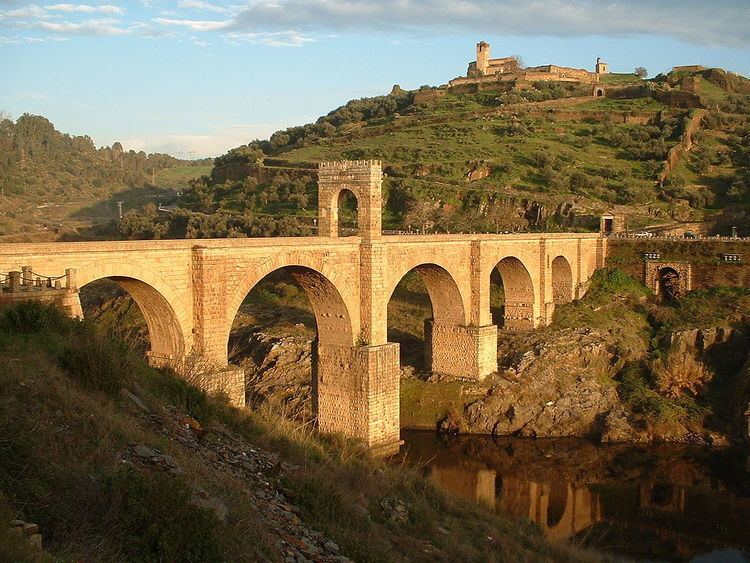9,500, 12 guns 2,000, 2–6 guns | light 250 | |
 | ||
The Battle of Alcantara (14 May 1809) saw an Imperial French division led by Marshal Claude Perrin Victor attack a Portuguese detachment under Colonel William Mayne. After a three hours skirmish, the French stormed across the Alcántara Bridge and forced the Portuguese to retreat. The clash happened during the Peninsular War, part of the Napoleonic Wars. Alcántara, Spain is situated on the Tagus river near the Portuguese border, 285 kilometres (177 mi) west-southwest of Madrid.
Contents
While Marshal Nicolas Soult invaded northern Portugal in early 1809, two other French forces stood ready to cooperate in the subjugation of Portugal. Pierre Belon Lapisse's division lurked near Ciudad Rodrigo while Victor's I Corps operated in the Tagus valley. A weak force under Robert Thomas Wilson watched Lapisse while Alexander Randoll Mackenzie's Anglo-Portuguese corps kept an eye on Victor. After being outgeneraled by Wilson, Lapisse marched south to join Victor. As Sir Arthur Wellesley's Anglo-Portuguese army disposed of Soult's corps, the detachment under Mayne moved to occupy Alcántara.
Believing Mayne's troops to be a serious threat, Victor marched against him. The Loyal Lusitanian Legion battalion stoutly defended the Alcántara Bridge for three hours. Then, the French artillery silenced their guns and a supporting battalion of militia took to its heels. The bridge was mined, but when Mayne ordered the charges to be detonated, its heavy construction withstood the explosion. Victor's infantry then rushed the incompletely demolished span. The French hung around the area for a few days but finally withdrew. The next action was the Battle of Talavera.
Background
Emperor Napoleon's strategy for early 1809 called for an invasion of Portugal by three columns. He ordered Marshal Nicolas Soult's 20,000 troops to advance from the north, General of Division Pierre Belon Lapisse's 9,000 men to come in from the east, and Marshal Claude Perrin Victor's soldiers to march from the south. Napoleon's plan called for Soult to capture Porto (Oporto) by 5 February 1809. From there, Soult was supposed to march to Lisbon and occupy it by the 16th of the same month. Meanwhile, Lapisse was directed to move from Salamanca to seize Ciudad Rodrigo and Almeida, Portugal as soon as Soult's II Corps got to Porto. Victor was ordered to be at Mérida by this time. He was instructed to detach a column from there to advance on Lisbon. The emperor assumed that Soult, Lapisse, and Victor would be easily able to send messengers to each other, and easily coordinate their operations. This assumption ignored the likelihood that Portuguese and Spanish guerillas would prevent Soult's dispatches from reaching his colleagues.
Soult marched south on 30 January 1809, aiming for Portugal. After being repelled in his initial attempt to cross the Minho River in mid-February, his forces marched to Ourense and crossed the bridge there. Soult's cavalry crushed a Spanish brigade at La Trepa on 6 March and the II Corps entered Portugal on the 9th. At the Battle of Braga (1809) on 20 March, the French routed a Portuguese army consisting of a few regulars and 22,000 militia. The First Battle of Porto on the 29th was another lopsided French victory marked by terrible Portuguese loss of life. But despite being established in Porto, Soult found his communications cut by General Silveira's regular and irregular forces and he had no idea of the whereabouts of Lapisse.
Meanwhile, Marshal Victor won a resounding victory over General Gregorio García de la Cuesta's Spanish army at the Battle of Medellín on 28 March 1809. Though he went on to occupy Mérida, Victor complained in dispatches to King Joseph Bonaparte that he lacked the strength to invade Portugal. He requested the return of Lapisse's division, but was refused.
Forces
An Anglo-Portuguese force under Major General Alexander Randoll Mackenzie watched the Portuguese frontier, based at Abrantes. The British element of this force included Brigadier General Henry Fane's 1,304-saber British cavalry brigade, Mackenzie's 2,709-man British infantry brigade, and May's 315-strong Royal Artillery battery. The 3rd Dragoon Guards and the 4th Dragoons were the mounted units while the 2nd Battalion of the 24th Foot, 3rd Battalion of the 27th Foot, 2nd Battalion of the 31st Foot, and the 1st Battalion of the 41st Foot were the infantry. The Portuguese contingent consisted of a cavalry brigade, an infantry brigade, and two artillery batteries. Five squadrons of the 3rd and 4th Dragoons made up the cavalry brigade. The infantry brigade comprised the 1st and 2nd Battalions of the 3rd, 4th, 13th, and 15th Line Regiments, the 1st Battalion of the 1st Regiment, and the 1st, 4th, and 5th Caçadores Battalions.
Battle
Wellington ordered Colonel William Mayne's 1st Battalion of the Loyal Lusitanian Legion, the Idanha Militia Battalion, and six Legion guns to serve as an outpost to Mackenzie's corps. The approximately 2,000 Portuguese came down from the mountains to the north and moved into Alcántara. Believing that Mayne's detachment was the spearhead of an offensive, Victor set out on 11 May to deal with the presumed threat.
The division with Victor was commanded by Lapisse. The 2nd Division of the I Corps consisted of three battalions each of the 16th Light Infantry Regiment and the 8th, 45th, and 54th Line Infantry Regiments. Including eight squadrons in one brigade of dragoons, Victor's force numbered 9,500 men and 12 guns. The horsemen belonged to General of Division Marie Victor de Fay, marquis de Latour-Maubourg's 1st Dragoon Division, which consisted of the 1st, 2nd, 4th, 9th, 14th, and 26th Dragoons. One authority wrote that Mayne's total of 1,850 men included one squadron of Legion cavalry and only two artillery pieces.
